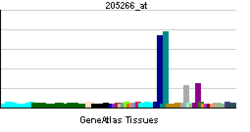From Wikipedia, the free encyclopedia
| Leukemia inhibitory factor | |||||||||||
|---|---|---|---|---|---|---|---|---|---|---|---|
 PDB rendering based on 1LKI. |
|||||||||||
|
|||||||||||
| Identifiers | |||||||||||
| Symbols | LIF; CDF; DIA; HILDA; MLPLI | ||||||||||
| External IDs | OMIM: 159540 MGI: 96787 HomoloGene: 1734 GeneCards: LIF Gene | ||||||||||
|
|||||||||||
| RNA expression pattern | |||||||||||
 |
|||||||||||
| More reference expression data | |||||||||||
| Orthologs | |||||||||||
| Species | Human | Mouse | |||||||||
| Entrez | 3976 | 16878 | |||||||||
| Ensembl | ENSG00000128342 | ENSMUSG00000034394 | |||||||||
| UniProt | P15018 | P09056 | |||||||||
| RefSeq (mRNA) | NM_001257135.1 | NM_001039537.1 | |||||||||
| RefSeq (protein) | NP_001244064.1 | NP_001034626.1 | |||||||||
| Location (UCSC) | Chr 22: 30.64 – 30.64 Mb |
Chr 11: 4.26 – 4.27 Mb |
|||||||||
| PubMed search | [1] | [2] | |||||||||
Binding/activation
LIF binds to the specific LIF receptor (LIFR-α) which forms a heterodimer with a specific subunit common to all members of that family of receptors, the GP130 signal transducing subunit. This leads to activation of the JAK/STAT (Janus kinase/signal transducer and activator of transcription) and MAPK (mitogen activated protein kinase) cascades.[citation needed]Expression
LIF is normally expressed in the trophectoderm of the developing embryo, with its receptor LIFR expressed throughout the inner cell mass. As embryonic stem cells are derived from the inner cell mass at the blastocyst stage, removing them from the inner cell mass also removes their source of LIF.Use in stem cell culture
Removal of LIF pushes stem cells toward differentiation, but they retain their proliferative potential or pluripotency. Therefore LIF is used in mouse embryonic stem cell culture. It is necessary to maintain the stem cells in an undifferentiated state, however genetic manipulation of embryonic stem cells allows for LIF independent growth, notably overexpression of the gene Nanog.LIF is not required for culture of human embryonic stem cells.[3][4]
==================================================================
These comments from Wikepedia introduce our discussion today,
first of all, patient with leukemia have their cells stopped at various stage of differentiation
meaning some are stopped at baby stage, some at teenager stage, some at adult stage. And at each stage, the leukemia takes a different Name, agressiveness and prognosis. In General, the younger the stage the bad/worse the prognosis. So there is a benefit to HELP ALONG THE CELL TO GROWTH, IT ACTUALLY IS HELPFUL FOR THE CELL TO MATURE SO THAT THE TUMOR GETS A GOOD OR BETTER PROGNOSIS.
AS A MATTER OF FACT, THE MORE MATURE THE CELL BECOMES, THE LESS LIKELY IT WILL DIVIDE REDUCING THE LOAD OF THE TUMOR. THE MORE MATURE IT GETS, THE MORE LIKELY IT WILL GET OLD AND DIE OF A NATURAL DEATH.
ON THE OTHER END HOWEVER, THE MORE LIKELY IT MATURES, THE MORE LIKELY IT MAY COMPLETE OR PERFORM ITS NATURAL FUNCTION. SO IF ITS FUNCTION WAS TO BE ABLE TO SPREAD, THE MATURE CELL CAN SPREAD FASTER. THAT'S WHY SCIENTISTS ARE REPORTING THAT AN INHIBITOR TO THIS LIF MAY STOP THE SPREAD OF CANCER. THE MD ANDERSON HAS BEEN WORKING ON THIS AND HAVE REPORTED SOME SUCCESS! THE FIGHT IS ON!
No comments:
Post a Comment